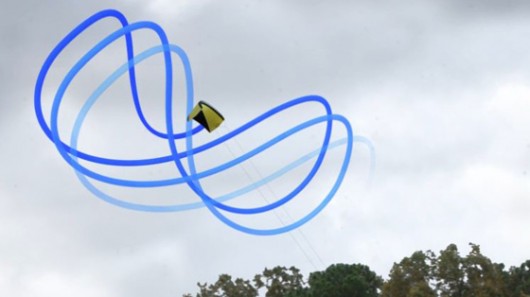NASA researchers aim to help get airborne wind power systems off the ground
By Darren Quick
21:20 July 4, 2012

The system developed at Langley flies a kite in a figure-8 pattern to power a generator on the ground (Photo: NASA)
Currently, land-based tower wind turbines are the dominant source of wind power, but they take up a lot of space and generally need to be placed in high visibility areas, such as the tops of hills or ridges. They are also located close to the ground, where friction from the Earth’s surface slows the wind and increases its turbulence, negatively affecting the efficiency of the turbines. NASA engineers are looking at technologies that would help airborne wind power systems, capable of generating much more power, get off the ground.
There are two basic types of kite-based airborne wind-energy systems. “Flygen” systems see turbines built into the kite that generate the electricity and feed it via a tether to a storage or distribution device on the ground. The second features a ground-based generator that is powered by the reeling out of the tether as the kite catches the wind. By tacking the kite upwind like a sailboat, the periodic reeling-in phase takes much less energy – around 10 percent – than is produced by the reeling-out phase, resulting in a 90 percent net energy gain.
Both systems also rely on the aerodynamics of the kite and autonomous flight control. It is these two aspects of the technology that NASA researchers are looking to improve to help make airborne wind-energy systems a viable alternative to ground-based turbines.
"A lot of the systems that are flying have pretty cruddy aerodynamics," says David North, an engineer at NASA's Langley Research Center in Virginia. He points out that companies under deadline pressure from investors aren’t able to spend much time on the difficult challenge of optimizing the kite’s efficiency. "Here at NASA," he said, "we have the luxury of focusing very specifically on problems and not have to worry about getting a commercial product fielded by a certain date."
North says that, while several companies attempting to bring airborne wind energy to market have demonstrated autonomous flight, they have relied on sophisticated onboard electronics and flight-control systems, comparable to autopilot systems used on commercial aircraft. "Our goal is to simplify the whole thing," he said, "especially if we are only flying at 2,000 feet, which is in most cases below the clouds."
North and his colleagues at Langley achieved the world’s first sustained autonomous flight using only ground-based sensors on March 1, 2012. "The breakthrough we've made is we are basically using a cheapo digital webcam tied into a laptop computer (on the ground) to track the motion of the kite and keep it flying autonomously,” North explained.
The system developed by the NASA researchers builds on the principle that the tips of a wind turbine’s blades generate as much as 90 percent of the turbine’s power because they are further from the hub and spin faster than the rest of the blade. In effect, placing a wind turbine at the end of a tether instead of it being attached to a concrete foundation allows the kite to act as a flying blade tip. It also allows the system to harness the much faster and steadier winds that can be found at higher altitudes.
The autonomous system functions in a similar way to Microsoft’s Kinect, with pattern recognition software determining where the kite is positioned, how it is oriented, and how fast it is moving. This data is fed into a flight-control system that keeps the kite in the air flying in a figure-8 pattern. The prototype kite only had a wingspan of about 10 feet (3 m), which is much smaller than the devices expected to be used in commercial applications. "Some people are talking very large, like wings the size of Boeing 747 airliners," North said
So far, the team’s test flights have been limited to low altitudes to avoid interfering with aircraft, but they are trying to gain permission to fly at 2,000 feet for long periods of time in the restricted airspace reserved for NASA above Wallops Island, Virginia. Above 2,000 feet is considered the sweet spot for airborne wind-energy systems.
While the research will benefit renewable energy generation on Earth, NASA says the airborne power-generation systems could also be put to use on neighboring worlds, such as Mars, Venus, and Titan.
"The funny thing about wind energy," North said, "is it goes by velocity cubed. So you can still extract significant amounts of energy even if the density is very low (like the thin atmosphere on Mars)."
Source: NASA
Copyright © gizmag 2003 - 2012 To subscribe or visit go to: http://www.gizmag.com